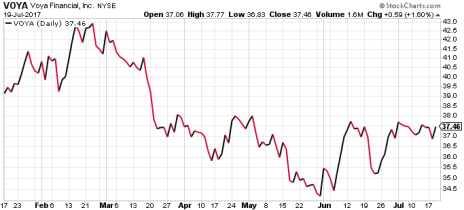One of my favorite stock investment profiles is one that I call a “buy low opportunity.” These are typically companies that are going through major changes that are catapulting their balance sheets and profits into glowing situations—but the stock market and investors have not yet capitalized on them.
Examples of recent buy low opportunity stocks include Adobe Systems (ADBE) as it went through its transformation into using a subscription revenue model, Kraft Heinz (KHC)after the completion of its 2015 merger and Vertex Pharmaceuticals (VRTX) as it transitioned from a biotech company with annual net losses to one with aggressive earnings growth. (Readers who followed my advice to buy VRTX enjoyed a 20% jump in the stock last week as the company released excellent clinical study results.)
[text_ad use_post='129629']
Today, I’d like to introduce a similarly transitioning company, the result of a 2013 spinoff that’s now aggressively growing its return on equity (ROE). I believe its transformation should result in significant Wall Street attention and praise in the coming years. The company is Voya Financial (VOYA), and it is a good buy low opportunity.
Voya Financial offers products and services in the areas of retirement planning, investment management, annuities, individual life insurance and employee benefits. The company is a leader in retirement planning, with a stated goal of becoming “America’s Retirement Company.” Voya Financial was formerly known as ING U.S., which had been spun off from ING Group N.V. in May 2013.
Voya employs approximately 6,700 people serving about 13.6 million customers through 225,000 points of distribution. The company finished 2016 with a total of $484 billion in assets under management (AUM) and advisement (AUA).
In recent years, Voya has been focused on improving its ROE, which rose from 8.3% in 2012 to 12.2% in 2015. Voya is currently aiming for an ROE range of 13.5% to 14.5% in 2018.
Voya has an investment grade credit rating on its senior unsecured notes of bbb+ from A.M. Best.
Voya achieved adjusted earnings per share (EPS) of $2.61 in 2016 (December year-end). Wall Street analysts are currently expecting Voya to earn $3.55 and $4.46 per share in 2017 and 2018 (December year-end), reflecting aggressive earnings growth rates of 36% and 25.6%. There are currently 14 analysts covering the stock and reporting those eye-popping earnings growth rates to their retail and institutional clients, which should certainly garner a lot of attention and buying activity in the coming months.
Even better, the corresponding price/earnings ratios (P/Es) are incredibly low at 10.6 and 8.4! As a matter of fact, Voya’s stock has the lowest 2018 P/E and the lowest price-to-book ratio of any of the top dozen of its life insurance peers, including Hartford Financial Services (HIG), Metlife (MET) and Prudential Financial (PRU). This extreme undervaluation of the share price caused a major Wall Street investment banker to assess VOYA as having 38% capital gain potential, far more than all of its insurance peers.
The company will report second-quarter 2017 results on the morning of August 2. Investors may tune in to the earnings conference call webcast at 10 a.m. ET on the company’s website.
Voya pays a very small dividend to shareholders yielding 0.11%. The company is expected to repurchase approximately $910 million of stock in 2017.
In the two years subsequent to its spinoff from ING Group N.V., VOYA rose from about 19 to 48, then slowly declined to a 2016 trading range between 23 and 33.
More recently, VOYA shot up to 43 in the post-U.S. election bull market, then had a price correction, stabilizing in a range between 33 and 38. Now that VOYA appears ready to emerge from that trading range and head higher, I’m putting a Buy recommendation on the stock.
There’s room for short-term traders to make about 13% profit in this buy low opportunity as VOYA retraces its February high at 43. Longer-term investors should keep VOYA at that point, because the stock is extremely attractive from both growth and value perspectives. Expect VOYA’s price increase to come to a temporary halt when it reaches 48, where it will likely need to rest after its big upward move.
If you’d like more Buy Low Opportunities, consider a subscriptions to my advisory, Cabot Undervalued Stocks Advisor. Click here for information.
[author_ad]

